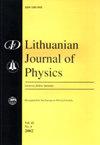Li+ intercalation current generation in amorphous and crystalline MoS2: Experiment and theory
IF 0.3
4区 物理与天体物理
Q4 PHYSICS, MULTIDISCIPLINARY
引用次数: 0
Abstract
In this work, crystalline and amorphous nano-MoS2 materials for effective Li+-intercalation current generation have been synthesized. The effect of disordering on the structural and electrochemical properties of nano-MoS2 has been systematically investigated by multiple characterizations: transmission electron microscopy (TEM), X-ray diffraction method and electrochemical measurements. Thermodynamic and kinetic peculiarities of intercalation processes have been studied. Dependences of the change in Gibbs’ free energy of the intercalation reaction on the extent of ‘guest’ lithium loading are analyzed. The distinctive feature of disordered structures is their ability to show colossal lithium ‘guest’ load, which ensures the specific capacity of the material in cathode processes up to ~2500 mAh·g–1 under the discharge not less than 2.6 V relative to lithium. The diffusion coefficient of lithium cations in the structure of disordered nano-MoS2 is two orders of magnitude higher than that in the crystalline MoS2.A quantum-mechanical model of the observed phenomena is suggested.非晶和结晶二硫化钼中Li+嵌入电流的产生:实验与理论
本文合成了晶体型和非晶型纳米二硫化钼材料,用于有效的Li+插层电流产生。通过透射电子显微镜(TEM)、x射线衍射法和电化学测量等多种表征手段,系统地研究了无序化对纳米二硫化钼结构和电化学性能的影响。研究了插层过程的热力学和动力学特性。分析了插层反应的吉布斯自由能变化与“客”锂负载程度的关系。无序结构的显著特征是它们能够显示巨大的锂“客”负载,这确保了材料在阴极过程中的比容量高达~2500 mAh·g-1,相对于锂的放电不低于2.6 V。锂离子在无序纳米二硫化钼结构中的扩散系数比在结晶二硫化钼结构中的扩散系数高2个数量级。提出了观测到的现象的量子力学模型。
本文章由计算机程序翻译,如有差异,请以英文原文为准。
求助全文
约1分钟内获得全文
求助全文
来源期刊

Lithuanian Journal of Physics
物理-物理:综合
CiteScore
0.90
自引率
16.70%
发文量
21
审稿时长
>12 weeks
期刊介绍:
The main aim of the Lithuanian Journal of Physics is to reflect the most recent advances in various fields of theoretical, experimental, and applied physics, including: mathematical and computational physics; subatomic physics; atoms and molecules; chemical physics; electrodynamics and wave processes; nonlinear and coherent optics; spectroscopy.
 求助内容:
求助内容: 应助结果提醒方式:
应助结果提醒方式:


